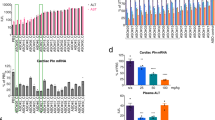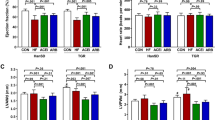Abstract
Angiotensin-converting enzyme (ACE) activity in the myocardium and angiotensin-II (Ang-II) levels in plasma increase after myocardial ischemia, which lead to exacerbation of myocardial injury and cardiac dysfunction. We examined the protective role of novel antisense-oligodeoxynucleotide (AS-ODN) directed at ACE mRNA in myocardial ischemic injury. Sprague–Dawley rats were treated with ACE-AS-ODN (200 μg per rat, n = 8, i.v.) or inverted-ODN (IN-ODN, 200 μg per rat, n = 8, i.v.), given with 600 μg per rat of liposome DOTAP/DOPE. Hearts from AS-ODN- or IN-ODN-treated rats were excised, perfused in vitro, and subjected to 25 min of global ischemia followed by 30 min of reperfusion. Parallel groups of rats were given ACE inhibitor captopril (5 mg/kg, n = 8) or saline (n = 8) before excising the hearts. Ischemia/reperfusion resulted in myocardial dysfunction (increase in coronary perfusion pressure and LV end-diastolic pressure and a decrease in developed LV pressure) in the saline-treated rats. Myocardial dysfunction was associated with evidence of lipid peroxidation and enzyme leakage (MDA and LDH levels in the myocardium) and up-regulation of ACE protein expression. Administration of AS-ODN or captopril, but not IN-ODN, reduced Ang-II levels in the plasma, decreased ischemia/reperfusion-mediated cardiac functional deterioration and lipid peroxidation, and preserved LDH in the myocardium (all P < 0.05 versus the saline group). AS-ODN and captopril had equipotent effects on cardiac dynamics. ACE protein expression (western blot) was decreased in the hearts of the AS-ODN-treated group, but not in IN-ODN-treated rat hearts. In contrast, ACE protein expression was significantly increased in captopril-treated rat hearts. These observations suggest that AS-ODN directed at ACE mRNA can ameliorate myocardial dysfunction and injury after ischemia/reperfusion, and its use is associated with decreased expression of ACE protein in the ischemic myocardium.
This is a preview of subscription content, access via your institution
Access options
Subscribe to this journal
Receive 12 print issues and online access
$259.00 per year
only $21.58 per issue
Buy this article
- Purchase on Springer Link
- Instant access to full article PDF
Prices may be subject to local taxes which are calculated during checkout





Similar content being viewed by others
References
Fleetwood G, Boutinet S, Wood JM . Involvement of the renin-angiotensin system in ischemic damage and reperfusion arrhythmias in the isolated rat heart J Cardiovasc Pharmacol 1991 17: 351–356
Martonrana PA et al. Reduction of infarct size by locial angiotensin-converting enzyme inhibition is abolished by a bradykinin antagonist Eur J Pharmacol 1990 182: 395–396
Hartman JC, Wall TM, Hullinger TG, Shebuski RJ . Reduction of myocardial infarct size in rabbits by ramipilat: reversibly the bradykinin antagonist HOE140 J Cardiovasc Pharmacol 1993 21: 996–1003
Hoshida S et al. Amelioration by Quinapril of myocardial infarction induced by coronary occlusion/ reperfusion in a rabbit model of atherosclerosis Circulation 1999 99: 434–440
Rice GI, Foy CA, Grant PJ . Angiotensin converting enzyme and angiotensin II type 1-receptor gene polymorphisms and risk of ischemic heart disease Cardiovasc Res 1999 41: 746–753
Marian AJ et al. Angiotensin-converting enzyme polymorphism in hypertrophic cardiomyopathy and sudden cardiac death Lancet 1993 342: 1085–1086
Schunker H . Polymorphism of the angiotensin-converting enzyme gene and cardiovascular disease J Mol Med 1997 75: 867–875
Cambien F et al. Deletion polymorphism in the gene for angiotensin-converting enzyme is a potent risk factor for myocardial infarction Nature 1992 359: 641–644
Tan LB et al. Cardiac myocyte necrosis induced by angiotensin II Circ Res 1991 69: 1185–1195
Hadyuk K, Boucher R, Genest J . Renin activity and content in various tissues in dogs under different pathophysiological states Proc Soc Exp Biol Med 1970 134: 252–255
Kobayashi T et al. Endothelin-converting enzyme in failing hearts of rats with myocardial infarction J Cardiovasc Pharmacol 1998 31 (Suppl. 1): S417–S420
Morales C, Rodríguez M, Scapín O, Gelpi RJ . Comparison of the ACE inhibition with those of angiotensin II receptor antagonism on systolic and diastolic myocardial stunning in isolated rabbit heart Mol Cell Biochem 1998 186: 117–121
Matoba S et al. Cardioprotective effect of angiotensin-converting enzyme inhibition against hypoxia/reoxygenation injury in cultured rat cardiac myocytes Circulation 1999 99: 817–822
Kitakaze M et al. Beneficial effects of inhibition angiotensin-converting enzyme on ischemic myocardium during coronary hypoperfusion in dogs Circulation 1995 92: 950–961
Pfeffer M Braunwald E, Boye L, the SAVE Investigators . Effect of captopril on mortality and morbidity in patients with left ventricular dysfunction after myocardial infarction N Engl J Med 1992 327: 669–677
The SOLVD Investigators . Effect of enalapril on mortality and the development of heart failure in asymptomatic patients with reduced left ventricular ejection fractions N Engl J Med 1992 327: 685–691
Sinnaeve P, Varenne O, Collen D, Janssens S . Gene therapy in the cardiovascular system: an update Cardiovasc Res 1999 44: 498–506
Poston RS et al. Antisense oligodeoxynucleotides prevent acute cardiac allograft rejection via a novel, nontoxic, highly efficient transfection method Transplantation 1999 68: 825–832
Poston RS et al. Ex vivo gene therapy prevents chronic graft vascular disease in cardiac allografts J Thorac Cardiovasc Surg 1998 116: 386–396
Phillips MI . Antisense inhibition and adeno-associated viral vector delivery for reducing hypertension Hypertension 1997 29: 177–187
Phillips MI, Wielbo D, Gyurko R . Antisense inhibition of hypertension. A new strategy for renin-angiotensin candidate genes Kid Intl 1994 46: 1554–1556
Aoki M et al. Efficient in vivo gene transfer into the heart in the rat myocardial infarction model using the HVJ (hemagglutinating virus of Japan)–liposome method J Mol Cell Cardiol 1997 29: 949–959
Mehta JL, Phillips MI . Increase in plasma angiotensin II levels after chemical blockade of AT1 receptor blockers, but not with antisense oligodeoxynucleotides directed at AT1 receptor mRNA: a major benefit of gene therapy J Cardiovasc Pharmacol Ther 1999 4: 135–136
Zhang YC, Bui JB, Phillips MI . Antisense inhibition of β1-adrenoceptor mRNA in a single dose produces a profound and prolonged reduction in high blood pressure in spontaneously hypertensive rats Circulation 2000 101: 682–688
Yang BC et al. Critical role of AT1 receptor expression after ischemia/reperfusion in isolated rat hearts: beneficial effect of antisense oligodeoxynucleotides directed at AT1 receptor mRNA Circ Res 1998 83: 552–559
Chen HJ et al. Protection against myocardial dysfunction induced by global ischemia/reperfusion by antisense-oligodeoxynucleotides directed at β1-adrenoceptor mRNA J Pharmacol Exp Ther 2000 294: 722–727
Passier RC et al. Activation of angiotensin-converting enzyme expression in infarct zone following myocardial infarction Am J Physiol 1995 269: H1268–H1276
Boomsma F, DeBruyn JHB, Derkx FHM, Schalekamp MADH . Opposite effects of captopril on angiotensin I-converting enzyme activity and concentration, relation between enzyme inhibition and long-term blood pressure response Clin Sci 1981 60: 491–498
Sassano P et al. Treatment of mild to moderate hypertension with or without the converting enzyme inhibitor enalapril. Results of a six-month double-blind trial Am J Med 1987 83: 227–235
Costerousse O et al. Angiotensin I-converting enzyme inhibition but not angiotensin II suppression alters angiotensin I-converting enzyme gene expression in vessels and epithelia J Pharmacol Exp Ther 1998 284: 1180–1187
Jansson K et al. The circulating renin-angiotensin system during treatment with metoprolol or captopril in patients with heart failure due to non-ischaemic dilated cardiomyopathy J Intern Med 1999 245: 435–443
Wei CC et al. Evidence for angiotensin-converting enzyme- and chymase-mediated angiotensin II formation in the interstitial fluid space of the dog heart in vivo Circulation 1999 99: 2583–2589
Weber B, Nussberger J, Juillerat L, Brunner HR . Angiotensin converting enzyme inhibition: discrepancy between antihypertensive effect and suppression of enzyme activity J Cardiovasc Pharmacol 1989 14 (Suppl. 4): S53–S59
Arnal JF et al. ACE in three tunicae of rat aorta: expression in smooth muscle and effect of renovascular hypertension Am J Physiol 1994 267: H1777–H1784
Schunkert H et al. Feedback regulation of angiotensin converting enzyme activity and mRNA levels by angiotensin II Circ Res 1993 72: 312–318
Heusch G, Rose J, Ehring T . Cardioprotection by ACE inhibitors in myocardial ischaemia/reperfusion. The importance of bradykinin Drugs 1997 54 (Suppl. 5): 31–41
Muller CA et al. Combination of a calcium antagonist, verapamil, with an angiotensin converting enzyme inhibitor, trandolapril, in experimental myocardial ischemia and reperfusion: antiarrhythmic and hemodynamic effects of chronic oral pretreatment Cardiovasc Drugs Ther 1998 12: 449–455
Ali SM, Brown EJ Jr, Nallapati SR, Alhaddad IA . Early angiotensin converting enzyme inhibitor therapy after experimental myocardial infarction prevents left ventricular dilation by reducing infarct expansion: a possible mechanism of clinical benefits Cor Artery Dis 1998 9: 815–821
Komuro I, Kudoh S . The role of angiotensin II in the development of cardiovascular remodeling Nippon Rinsho 1999 57: 1090–1095
Sands H et al. Biodistribution and metabolism of internally 3H-labeled oligonucleotides. I. Comparison of a phosphodiester and a phosphorothioate Mol Pharmacol 1994 45: 932–943
Zhang R et al. Pharmacokinetics and tissue distribution in rats of an oligodeoxynucleotide phosphorothioate (GEM 91) developed as a therapeutic agent for human immunodeficiency virus type-1 Biochem Pharmacol 1995 49: 929–939
Khaper N, Singal PK . Effects of afterload-reducing drugs on pathogenesis of antioxidant changes and congestive heart failure in rats J Am Coll Cardiol 1997 15: 856–861
Haklar G et al. Protective effects of cilazapril against free radical injury in myocardial ischaemia-reperfusion Pharmacol Res 1995 31: 33–36
Li DY et al. Upregulation of endothelial receptor for oxidized low-density lipoprotein (LOX-1) in cultured human coronary artery endothelial cells by angiotensin II type 1 receptor activation Circ Res 1999 84: 1043–1049
Corvol P, Michaud A, Soubrier F, Williams TA . Recent advances in knowledge of the structure and function of the angiotensin I converting enzyme J Hypertens 1995 13 (Suppl. 3): S3–S10
Koike G et al. Angiotensin converting enzyme and genetic hypertension: cloning of rat cDNAs and characterization of the enzyme Biochem Biophys Res Commun 1994 198: 380–386
Neely TR, Rovetto MJ . Techniques for perfusing isolated rat hearts Meth Enzymol 1975 39: 43–60
Li DY et al. Modulation of constitutive nitric oxide synthase, bcl-2 and Fas expression in cultured human coronary endothelial cells exposed to anoxia-reoxygenation and angiotensin II: role of AT1 receptor activation Cardiovasc Res 1999 41: 109–115
Chomczynski PK, Sacchi N . Single step method of RNA isolation by acid guanidinium thiocyanate-phenol-chloroform extraction Anal Biochem 1987 162: 156–159
Ohkawa H, Ohishi N, Yahi K . Assay for lipid peroxides in animal tissues by thiobarbituric acid reaction Anal Biochem 1979 95: 351–358
Hermann K, Ring J, Phillips MI . High-performance liquid chromatography for the separation of angiotensin and its metabolites in human plasma and sweat J Chromat Sc 1990 28: 524–529
Acknowledgements
This work was supported by grants from the Veterans Affairs and the Department of Defense and a MERIT Award from the National Institutes of Health.
Author information
Authors and Affiliations
Rights and permissions
About this article
Cite this article
Chen, H., Mohuczy, D., Li, D. et al. Protection against ischemia/reperfusion injury and myocardial dysfunction by antisense-oligodeoxynucleotide directed at angiotensin-converting enzyme mRNA. Gene Ther 8, 804–810 (2001). https://doi.org/10.1038/sj.gt.3301439
Received:
Accepted:
Published:
Issue Date:
DOI: https://doi.org/10.1038/sj.gt.3301439
Keywords
This article is cited by
-
Non-viral gene delivery strategies for gene therapy: a “ménage à trois” among nucleic acids, materials, and the biological environment
Journal of Nanoparticle Research (2013)
-
Overexpression of TGFβ1 by adeno-associated virus type-2 vector protects myocardium from ischemia–reperfusion injury
Gene Therapy (2008)



